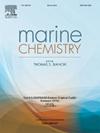Pollution assessment and ecological risk of organic contaminants in a river-estuary of the northeastern Brazilian semi-arid: Traditional and emerging contaminants unraveling rural and urban activities
IF 2.5
3区 地球科学
Q2 CHEMISTRY, MULTIDISCIPLINARY
引用次数: 0
Abstract
Surface sediments from the Jaguaribe River, in a Brazilian semi-arid region, were investigated for the presence of traditional and emerging organic contaminants to identify the multiple pollution sources in the area. Aliphatic and polycyclic aromatic hydrocarbons were linked to phytoplankton, microbiological species, specific vegetation, and minimal petroleum and pyrolysis compounds. Regarding sterols, higher contributions from stigmasterol and cholesterol were associated with higher plants and zooplankton, respectively. However, coprostanol levels suggested fecal contamination from large mammals, corroborated by the predominance of synthetic over natural hormones. The main origins found for pesticides were their use in health campaigns, agriculture, and domestic use. The toxicity assessment revealed that all stations presented a high risk to biota, especially from hormone and pesticide compounds. This multimolecular approach allowed the identification and differentiation of pollution sources from urban and rural activities and the potential risk for the biota in an important region of Brazil.

巴西东北部半干旱河口有机污染物的污染评估和生态风险:农村和城市活动中传统和新出现的污染物
研究了巴西半干旱区Jaguaribe河表层沉积物中传统和新兴有机污染物的存在情况,以确定该地区的多重污染源。脂肪族和多环芳烃与浮游植物、微生物物种、特定植被和少量石油和热解化合物有关。在固醇方面,豆甾醇和胆固醇的贡献分别与较高的植物和浮游动物有关。然而,coprostanol水平表明来自大型哺乳动物的粪便污染,合成激素优于天然激素证实了这一点。杀虫剂的主要来源是卫生运动、农业和家庭使用。毒性评价结果显示,各监测站对生物区系的危害较大,尤其是激素和农药化合物对生物区系的危害较大。这种多分子方法可以识别和区分来自城市和农村活动的污染源以及对巴西一个重要地区生物群的潜在风险。
本文章由计算机程序翻译,如有差异,请以英文原文为准。
求助全文
约1分钟内获得全文
求助全文
来源期刊

Marine Chemistry
化学-海洋学
CiteScore
6.00
自引率
3.30%
发文量
70
审稿时长
4.5 months
期刊介绍:
Marine Chemistry is an international medium for the publication of original studies and occasional reviews in the field of chemistry in the marine environment, with emphasis on the dynamic approach. The journal endeavours to cover all aspects, from chemical processes to theoretical and experimental work, and, by providing a central channel of communication, to speed the flow of information in this relatively new and rapidly expanding discipline.
 求助内容:
求助内容: 应助结果提醒方式:
应助结果提醒方式:


